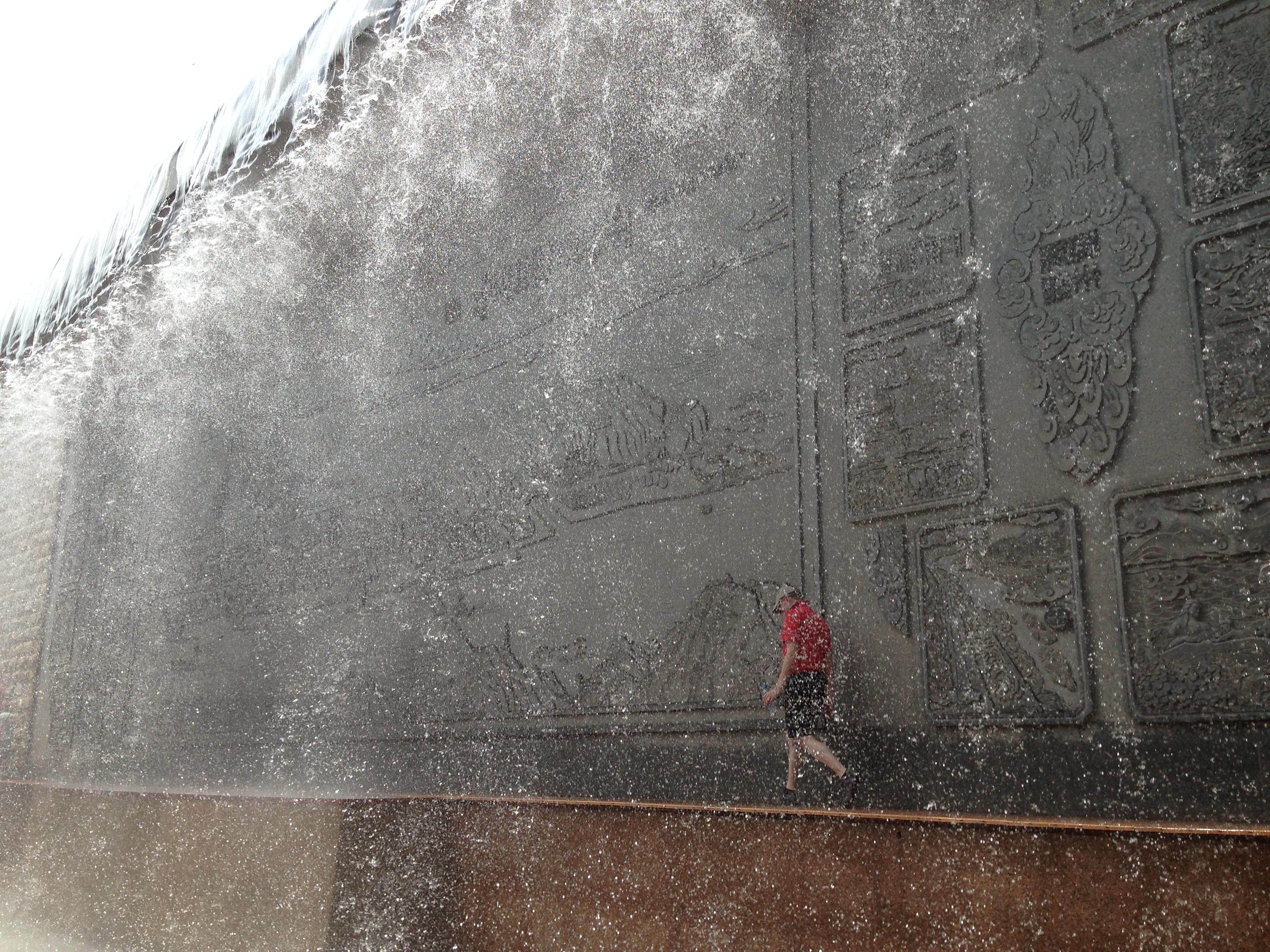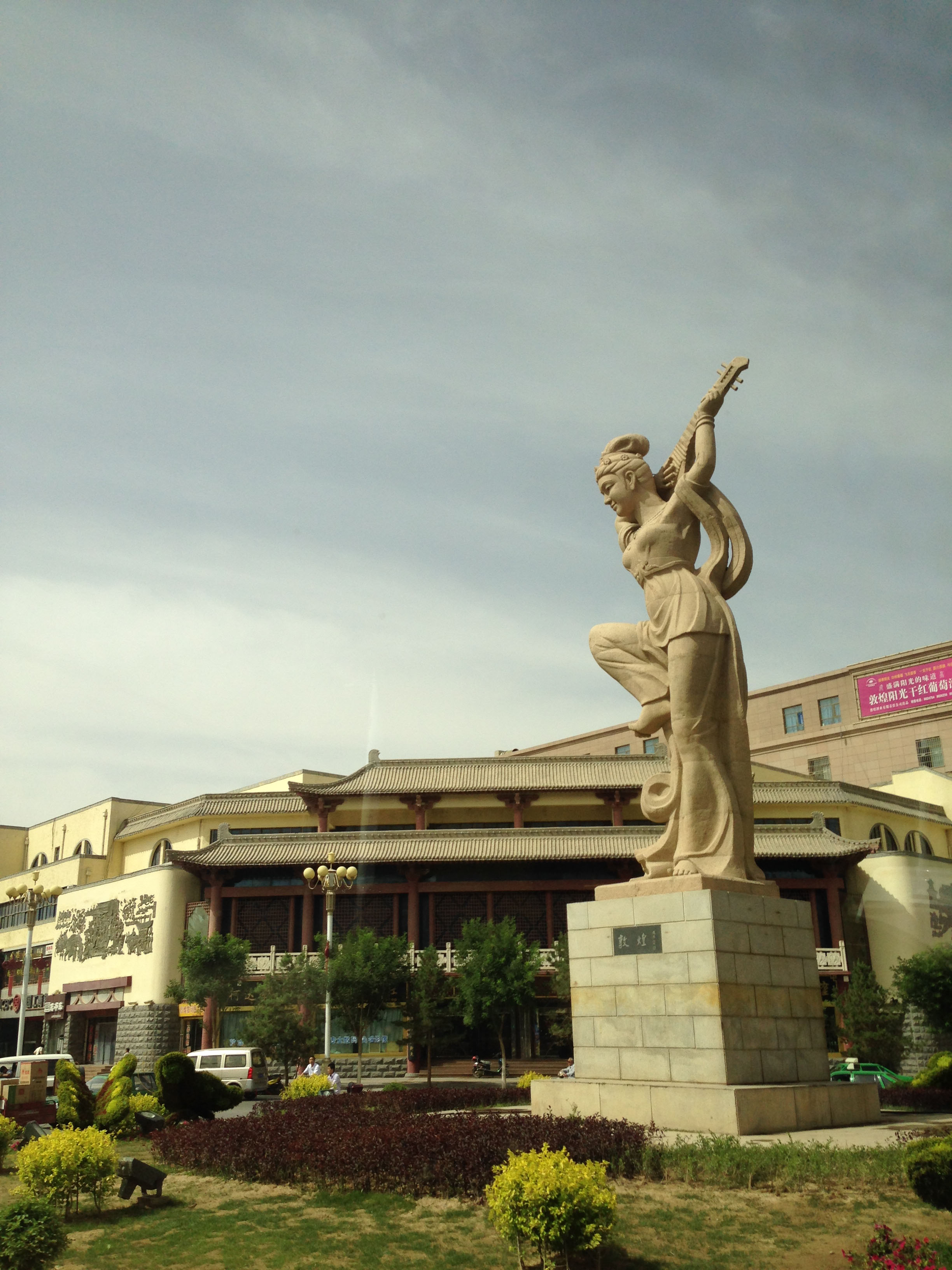By Amanda Heston & Aissa Castillo
Exploring Lanzhou (Aissa Castillo)
After flying into Lanzhou, the group was understandably tired but determined to enjoy the mysterious wonders Lanzhou might have in store for us. Some were excited by the prospect that at last in the western area of China we might encounter the seedy margins. Unfortunately (or perhaps fortunately) the margins brought to you by a tour guide are never as seedy as you might imagine.
The group was able to enjoy an early outing exploring the area around the Yellow River. In this picture we are posed in front of the river, about to explore the area’s many Buddhist temples as well as the famed bird’s eye view of the city.
While climbing the many steps leading to the bird’s eye view of Lanzhou, the group was treated to a constructed water wall that actually offered passersby the opportunity to run behind to feel the spray of water. Most of the members of the group took advantage of this given the heat that surrounded us. (Some of us, including Professor Sheehan, resisted the impulse to run and simply walked across.)
After a 20 minute or so hike consisting mainly of stairs, the group was able to reach the top. We were treated to a panoramic view of Lanzhou and the Yellow River that made the steep hike more than worth the wait.
After returning from the bird’s eye view, the group was then taken to see the statue of the Mother River. This is a depiction of the river that was created in the 1980’s and many tourists come to take pictures with it and to absorb its cultural symbolism.
Still feeling the effects of our early flight departure and the multitude of steps that led to the bird’s eye view, many of us opted to take in the scenery of the river and enjoy a local shop’s offering of “Muslim Tea.” This was a delightfully refreshing concoction of longan, dried dates, tea, and rock sugar. For many of us this was a lull in a busy schedule that would see us all boarding a 14 hour sleeper train to Dunhuang before the night was over!
You might not think it by looking at the photo but this is the group directly off our sleeper train to Dunhuang, a sandy city in the Gobi Desert. I think it’s fair to say that sharing enclosed bunks, a few sinks, and one very suspicious squat toilet made us all a little closer together.
Off to Dunhuang (Amanda Heston)
After arriving in Dunhuang Monday morning, we drove into town and got a taste of local history from our tour guide Lily on the way to our hotel. She told us about a relatively new statue of a woman playing lute behind her head that had been positioned in the middle of town. We learned that this woman was becoming a symbol for the city and was meant to represent its diverse history as a cosmopolitan center on the Silk Road. It wasn’t until later that we understood the fuller Buddhist implications behind the statue–that afternoon at the Mogao Grottoes, caves carved out of a sandstone mountain that were once used by Buddhist monks for meditation and study.
We began our trip to the grottoes after settling into our hotel rooms and eating a quick lunch of slightly spicier cuisine than our group had been used to at our more eastern destinations. While beautiful, the sandstone cliffs certainly didn’t do justice to what we were about to see inside.
Unfortunately, we were quickly told upon arrival that no photography would be allowed inside the caves and snapped a couple outside instead. One of our best group pictures came out in front of the entry arch!
Even though we had read about the caves the previous week and seen lots of photos of the interiors, it was still shocking to see how well the paintings and carvings had been preserved in the dry desert climate of Dunhuang. Our tour guide Serena showed us a hidden cave and brought us to a short museum that explained how many of the Buddhist sutras and artwork that had once been in the hidden cave were no longer in China’s possession and instead had been scattered throughout the world in places like London, India, and the US. We then entered the progressively magnificent caves, with the peak being the cave containing a three-story-tall Buddha built during the MING Dynasty. Needless to say, we were all speechless.
That evening, we decided to head out to the Dunhuang night market and were surprised by the great stuff we found there. Vendors sold everything from carved wooden landscapes to dried apricots (Dunhuang’s specialty) to lamb kabobs.
The next day, Tuesday, was set up to be one of the busiest days yet. We had two excursions and two plane rides back to Shanghai in the afternoon and evening. The morning started out with a trip to the Gobi Desert sand dunes and Crescent Lake right outside the city, something I don’t think any of us were prepared for.
We saw camels everywhere and finally decided to hike one of the biggest dunes in hope of finding a great view or something to do at the top. We managed to get to the top and had a great view of the lake and the sand dunes that continued on in all directions.
After appreciating the view, many of us decided to pay about $2 to take a sled down the enormous dune we had just hiked up, while others decided to travel a bit further up and just appreciate the view.
By the end of the excursion, we had sand everywhere and definitely needed to head back to the hotel to clean ourselves up. After having only forty-five minutes to shower and pack our bags, we grabbed a quick lunch and headed into the Dunhuang Museum for a whirlwind tour through the exhibits. Luckily, we were able to find a replica of one of the Mogao Grottoes to take a picture of and give an idea of what we saw the day before.
Finally, we arrived at the tiny Dunhuang Airport. It only had four gates, but it got us where we needed to be! We arrived in Xi’an a few hours later and then jumped on a plane to Shanghai shortly thereafter.
The plane rides were full of turbulence, sleep, and office hours with Professor Sheehan for our third assignment. But we still made it through and got home with the next day off to look forward to!















